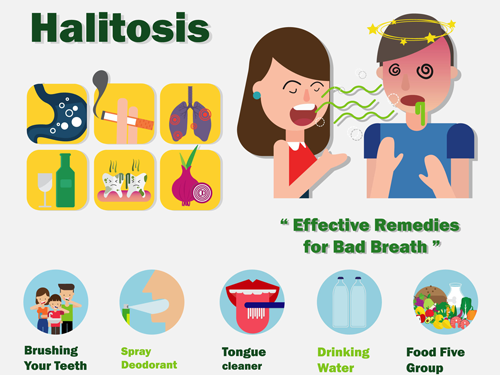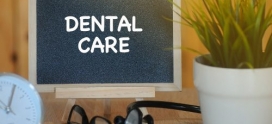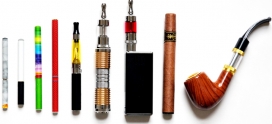How Bad is ‘Bad Breath’?
Bad breath, or Halitosis, can be a major problem, especially when you’re about to whisper a secret to your friend. When you open your mouth to talk, the last thing you want others to do is cringe in disgust or play a guessing game about what you had for lunch. Everyone suffers from bad breath once in a while. Good news is, that it can be detected, corrected and prevented.
Breath odor is the scent of the air one breathes out. Unpleasant breath odor is called bad breath or Halitosis. It’s a recognizable common complaint among the general population and a concern for many. The epidemiological research on halitosis is inadequate since it still is a considerable but underrated taboo. Its prevalence ranges from 50% (USA) to 6-23% (China) & studies state that its intensity increases with age. A thorough literature search reveals a lack of studies on halitosis in India, especially among the general population.
There is umpteen number of causes associated with bad breath. Most common are Strong foods (onion, garlic, cabbage, coffee, poorly pH balanced diet, condiments, spices, cheese & soda). Once these foods are digested, their oils are absorbed into the bloodstream and carried to the lungs. The odor is given off in the breath until all the food is digested. Poor oral health (ANUG, bleeding gums, cavities, irregular brushing, flossing, tooth abscess & dentures) – Bacterial wastes, food particle debris & decay produce sulfur compounds that cause bad breath. Habits like smoking & tobacco use.
In case of other conditions, halitosis that develops is unlikely to be an early feature & is an incidental finding during clinical examination. Such conditions are Medical disorders (Metabolic & Endocrinal causes, Gastrointestinal (GI) disorders, ENT problems, Lung disease etc), Medications (vitamin supplements in large doses, insulin shots, triamterene, paraldehyde), miscellaneous (stress, dieting, snoring, hormonal changes, morning mouth, hunger, fasting.)
Trivia related to halitosis:
- PHYSIOLOGICAL HALITOSIS (morning mouth) is caused by pooling of saliva, putrefaction of entrapped food particles & dead cells by the accumulation of bacteria on tongue & decreased liquid intake. This occurs during sleep when saliva production slows down resulting in the typical morning mouth odor. Morning mouth is also associated with hunger or fasting. It is saliva that helps wash away food particles & bacteria & check odor. Brushing twice & not skipping breakfast is the key for fresh breath.
- DELUSIONAL/ IMAGINARY HALITOSIS (monosymptomatic hypochondriasis) is a condition in which a person believes that his/ her breath odor is offensive & a cause of social nuisance. However, neither the doctor nor any confidant can approve of its existence. This condition has been poorly documented & was recently added to “psychosomatic disorders pertaining to dental practice.” Interestingly, advertisements of oral hygiene products are responsible for the increase in the number of patients with delusional halitosis.
- PSEUDO HALITOSIS patients are different from the above condition as they complain of having oral malodor without actually suffering from it. They eventually get convinced of a disease-free state during diagnosis & therapy. They make up for 28% of the halitosis population.
- HALITOPHOBIA is seen in 0.5-1% of adults & is the fear of having bad breath. Such patients need psychological counseling. Physician must keep in mind other causes of halitosis to confirm the final diagnosis of halitophobia.
- OLFACTORY REFERENCE SYNDROME is another psychological disorder in which there is a preconceived notion about one having bad breath or offensive body odor.
- DIETERS MOUTH happens to be a common condition amongst weight watchers. Dieters on low-carbs eat fewer amounts of carbohydrates thus allowing the body to burn stored fat. When the body burns fat as fuel, ketones are produced that are released in breath & cause halitosis. High-protein foods too produce sulfur compounds & add to the bad breath.
- TRAVELERS BREATH is not a commonly known condition. While traveling, saliva production slows down allowing bacteria to grow in the mouth resulting in bad breath. During travel, type & time of food change changes. Oral hygiene routine also becomes difficult to follow. This leaves food particles in the mouth that produce sulfur compounds causing bad breath. Hunger/ fasting is common in frequent fliers. In spite of maintaining oral hygiene, morning mouth may re-occur.
DIAGNOSIS & EVALUATION
If in spite of taking good dental care & following all the good habits essential for maintaining good fresh breath, halitosis persists, a visit to the dentist becomes essential. Dentist will diagnose & evaluate the cause of bad breath & detail out a treatment plan. This would involve taking a detailed history, asking questions related to the main complaint, medical & dental health, lifestyle, diet & habits & confirming an objective basis for the complaint. Halitosis history is discretely & intermittently recorded.
Next, a subjective examination based on smelling the exhaled air of mouth & nose is carried out & the 2 are compared. This is considered as the “gold standard” to diagnose halitosis in a clinical setup. Odor detectable from the mouth but not from the nose is likely to be of oral or pharyngeal origin. Odor from the nose alone is likely to be coming from the nose or sinuses. In rare instances, when the odor from the nose & mouth is of similar intensity, a systemic cause may be likely.
Finally, a physical examination is carried out which includes thorough inspection of mouth & nose. A throat culture may be taken in case of sore throat or mouth sores. In rare cases, tests may be performed to rule out underlying medical conditions.
Saliva odor test (wrist lick test) – patient licks the wrist which is allowed to dry up for 10s after which the trained clinician allows a score to it. Nasal breath odor – patient is asked to breathe normally with mouth closed and the clinician gives a score to the exhaled air. Scraping from the tongue dorsum is taken using a non-odorous spoon in case of gum problems. These methods of directly assessing the exhaled air are a bit uncomfortable. Alternatively, the patient may exhale into a paper bag, from which the odor can be examined. These methods are extremely subjective and lack quantification.
Specific, reliable objective methods are present too but are expensive, bulky & mainly confined for research. Examples for these are – Gas chromatography (GC), Portable volatile sulfide monitor, Dark-field microscopy, Quantifying b-galactosidase activity, Salivary incubation test, BANA test, Ammonia monitoring, Ninhydrin method, PCR, Taqman DNA, Tongue Sulfide Probe and Zinc Oxide Thin Film Conductor Sensor.
TREATMENT
One must keep in mind that patients with halitosis are anxious, looking for help & suspicious of any treatment, due to bad experience using traditional approaches. The following methods can be used for managing bad breath –
- Drinking plenty of water has a multifactorial effect in combating halitosis. It not only dilutes the concentration of ketones but cleanses teeth off odor-causing excess bacteria and food debris.
- Mechanical methods – tongue brushing/ scraping, interdental cleaning with the brush, flossing. Ideally, brushing should be done for full 2 minutes and not vigorously, to sufficiently clean all the surfaces of teeth. But, brushing alone won’t remove plaque and food debris stuck between teeth, hence flossing is important too. The key is tongue scraping which removes most of the odor-causing bacteria from the mouth.
- Chemical methods – mouthwash & rinsing. Mouthwash only gets rid of bad breath temporarily. Long-term use of mouthwash has shown to cause tooth staining and dry mouth. A good choice would be to choose an alcohol-free, bacteriocidal, simple mouthwash and use it sparingly.
- Masking products – Chewing sugarless gum after meals can help keep bad breath away. Saliva production increases during chewing which neutralizes acid production and rinses food particles. Chewing parsley also has the same effect as it too increases saliva production. Sugar-free gum with xylitol also helps in preventing caries. Xylitol is a natural sweetener and has shown to inhibit growth bacteria causing tooth decay. But this effect is temporary.
- Diet – Intake of fruits and vegetables should be increased. Foods & drinks causing bad breath should be avoided.
- Habit management – use of all tobacco-related products and smoking should be stopped.
- Lifestyle changes – which include skipping breakfast, fasting, keeping long gaps between meals and changing eating habits and patterns while traveling should be avoided
- Use of probiotics
- Removable denture wearers should soak their dentures overnight in a disinfecting solution & along with removable braces and retainers should also be cleaned regularly with soap and water
- Professional cleaning (scaling / oral prophylaxis) should be done every 6 months.
- Management of dental diseases
- Treatment of underlying systemic disorders
CONCLUSION
Halitosis is extremely unappealing & may have long-term detrimental after effects on psychosocial relationships. With proper diagnosis, identification of the causes & timely management, a successful individualized therapeutic approach can be made for anyone seeking assistance. It is important to develop an interdisciplinary method for the treatment of halitosis to prevent misdiagnosis or unnecessary treatment. The literature on halitosis is scarce and additional studies are required.
Photo Credit: Shutterstock
Dr. Rimjhim Saran Bhatnagar
BDS, MDS (Oral Medicine, Oral Radiology, Oral Diagnosis)
Consultant Specialist
Twitter: @DentistRimjhim
Email: response@dentistrimjhim.com



